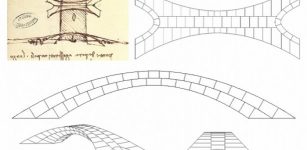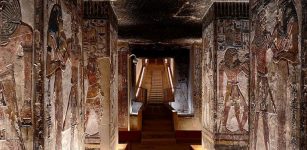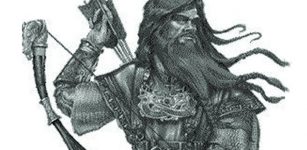Mysterious Mohenjo Daro Was Home To An Unknown Advanced Civilization Far Ahead Of Its Time
A. Sutherland - AncientPages.com - Thousands of years ago, the mysterious city of Mohenjo Daro was home to an unknown, advanced and prosperous civilization that used technology and constructed buildings that were unique to the ancient world.
Artifacts, relics and ruins reveal startling evidence that the inhabitants of Mohenjo Daro possessed inventions that were far ahead of their time.
How and from whom did these remarkable people acquire knowledge of such sophisticated technology?
Why did this enigmatic civilization vanish? The history of the ancient world is full of secrets.
Can some of the interesting archaeological discoveries cast more light on what really happened to one of the world's oldest and advanced civilizations?
The ruined great city of Mohenjo-Daro ("Mound of the Dead") was once a major urban center of the Harappa Culture or Indus Civilization, a highly developed civilisation that flourished on the banks of the rivers Indus and Saraswati, around 3000 BC. (in Pakistan now)
Excavations in 1920-22 at Harappa -Mohenjodaro (which lie in what is now Pakistan) confirmed the existence of an unknown civilization in the Indus Valley, the home of one of the oldest highly advanced civilizations of the world.
The sophistication of the infrastructure relating to the water supply and effluent disposal systems of the mysterious city was unique!
Why was Mohenjo-Daro abandoned?
The Indus Civilization collapsed around 2000 BC Mohenjo-Daro - discovered in 1922 - was a center of trade and manufacture built on two gigantic artificial mounds; a higher mound the so-called citadel or acropolis overlooked the lower mound considered as residential with hundreds of dwelling houses, larger buildings and a regular system of streets.
Mohenjo-Daro's infrastructute displaced very advanced techniques focused on water supply and effluent disposal systems, extremely important for public health.
This prehistoric society valued good roads, clean fresh water and a system of law.
Probably the most impressive building was a bath-house having absolutely no equal in cities until the Roman period. It was covered with a pool measuring 40 feet by 23 feet, with a steam-bath and a hot-air heating system.
When the city flourished, fresh water was supplied by a network of over 700 unique wells for drinking water, constructed in form of cylindrical shafts several meters deep.
Mohenjo-Daro's citizens used them long before Egypt and Mesopotamia, where water was still fetched from rivers to be stored in cisterns.

The Dancing Girl, the iconic bronze figurine of Mohenjodaro. (Benoy K. Behl/Collection: National Museum, New Delhi)
The city's engineers and masons also built bathrooms in every home while polishing the tiles of its grand ritual bath to a highly burnished waterproof glaze.
Unique water supply from wells was integrated with a drainage system. Waste water along with sewage from houses was channeled into a complex system of drains running along and below the streets.
The drains had removable covers to give access for cleaning. Cesspools and soakaway pots were commonly used and each bedroom had running water and a bathroom and lavatory.
The municipal sewerage was so efficient that according to British engineers, they could do no better at the present day.
Some interesting terracotta female figurines of the so-called "mother goddess" have been discovered at Mohenjo-Daro.
One of these figurines, dated to approximately 3000 BC, depicts a woman wearing extremely short mini skirt, a necklace and belt and only her face is rather strange and very unusual.
Was she looking like this, when this clay figurine was formed? Was it her real appearance?
If this was the case, one can say that the civilization of Mohenjo Daro had a lot in common with our modern society.
Among more than 40,000 artifacts unearthed in Mohenjo-Daro, there are hand-carved chess pieces, perfectly clay toy animals, and clay urns, platters, and ovens that highlight a culinary culture and stone weights and measures.
When the 5,000-year-old ruins of the city were first unearthed, it was one of the greatest archaeological discoveries. Today Mohenjo-Daro's situation is not is in danger to be completely destroyed and forgotten.
According to archaeologists, Mohenjo-Daro will most probably disappear within 20 years without an urgent rescue plan. If this happens, an important and valuable piece of our history will be lost.
Written by – A. Sutherland AncientPages.com Staff Writer
Copyright © AncientPages.com All rights reserved. This material may not be published, broadcast, rewritten or redistributed in whole or part without the express written permission of AncientPages.com
More From Ancient Pages
-
 Leonardo da Vinci’s 280-Meter Long Bridge Design – Tested
Archaeology | Oct 17, 2019
Leonardo da Vinci’s 280-Meter Long Bridge Design – Tested
Archaeology | Oct 17, 2019 -
 Huge Rare Runestone Found Under The Kitchen Floor In Randers Investigated
Archaeology | Jun 8, 2023
Huge Rare Runestone Found Under The Kitchen Floor In Randers Investigated
Archaeology | Jun 8, 2023 -
 Restorations At Stratonicea Ancient City Of Gladiators In Turkish Muğla Province
Archaeology | May 10, 2023
Restorations At Stratonicea Ancient City Of Gladiators In Turkish Muğla Province
Archaeology | May 10, 2023 -
 Schoolboy Finds A Huge 3,000,000-Year-Old Megalodon Shark Tooth On British Beach
Archaeology | May 9, 2022
Schoolboy Finds A Huge 3,000,000-Year-Old Megalodon Shark Tooth On British Beach
Archaeology | May 9, 2022 -
 Intriguing Connection Between Ancient Curse Tablets And The Book Of Revelation Discovered
Artifacts | Feb 9, 2023
Intriguing Connection Between Ancient Curse Tablets And The Book Of Revelation Discovered
Artifacts | Feb 9, 2023 -
 Why Pharaoh Seti I’s Tomb Had To Be The Most Glorious And Largest Ever Built In Valley Of The Kings
Featured Stories | Jun 19, 2021
Why Pharaoh Seti I’s Tomb Had To Be The Most Glorious And Largest Ever Built In Valley Of The Kings
Featured Stories | Jun 19, 2021 -
 Mystery Of The Ancient Lost Megalithic City Of Nhambiquaras And The Curious Roman Figurine
Featured Stories | Mar 4, 2022
Mystery Of The Ancient Lost Megalithic City Of Nhambiquaras And The Curious Roman Figurine
Featured Stories | Mar 4, 2022 -
 Disbelief In Human Evolution Is Linked To Prejudice And Racism – Scientists Say
Human Beginnings | Apr 5, 2022
Disbelief In Human Evolution Is Linked To Prejudice And Racism – Scientists Say
Human Beginnings | Apr 5, 2022 -
 Map Of Hidden NT Landscape Where First Australians Lived More Than 60,000 Years Ago
Archaeology | May 5, 2023
Map Of Hidden NT Landscape Where First Australians Lived More Than 60,000 Years Ago
Archaeology | May 5, 2023 -
 Ancient Secrets Of Polish Ciemna Cave Inhabited By Humans 120,000 Years Ago
Featured Stories | Nov 22, 2016
Ancient Secrets Of Polish Ciemna Cave Inhabited By Humans 120,000 Years Ago
Featured Stories | Nov 22, 2016 -
![Microscopy picture of a dividing basal radial glial cell, a progenitor cell type that generates neurons during brain development. Modern human TKTL1, but not Neandertal TKTL1, increases basal radial glia and neuron abundance. Credit: Pinson et al., Science 2022 / MPI-CBG Left: Microscopy picture of a dividing basal radial glial cell, a progenitor cell type that generates neurons during brain development. Modern human TKTL1, but not Neandertal TKTL1, increases basal radial glia and neuron abundance. [less] © Pinson et al., Science 2022 / MPI-CBG; Right: Anneline Pinson is a researcher in Wieland Huttner's group. © MPI-CBG](https://www.ancientpages.com/wp-content/uploads/2022/09/Brain12Neurons-307x150.jpg) Modern Humans Generate More Brain Neurons Than Neandertals
Human Beginnings | Sep 8, 2022
Modern Humans Generate More Brain Neurons Than Neandertals
Human Beginnings | Sep 8, 2022 -
 Fossil Bones From The Largest Penguin That Ever Lived Unearthed In New Zealand
Fossils | Feb 10, 2023
Fossil Bones From The Largest Penguin That Ever Lived Unearthed In New Zealand
Fossils | Feb 10, 2023 -
 Remarkable Discovery Of Unusual “Hammer Of Thor” Finally Solves An Ancient Mystery
Archaeology | Jul 2, 2014
Remarkable Discovery Of Unusual “Hammer Of Thor” Finally Solves An Ancient Mystery
Archaeology | Jul 2, 2014 -
 Giants Of The Jurassic Seas Were Twice The Size Of A Killer Whale – New Study
Fossils | May 11, 2023
Giants Of The Jurassic Seas Were Twice The Size Of A Killer Whale – New Study
Fossils | May 11, 2023 -
 Parthians: Their Great Empire And Skilled Horse Archers
Civilizations | Nov 10, 2016
Parthians: Their Great Empire And Skilled Horse Archers
Civilizations | Nov 10, 2016 -
 Vali – Son Of Odin, Who Avenged Death Of Balder And Survived Ragnarok
Featured Stories | Aug 29, 2019
Vali – Son Of Odin, Who Avenged Death Of Balder And Survived Ragnarok
Featured Stories | Aug 29, 2019 -
 Bees Originated From An Ancient Supercontinent Millions Of Years Earlier Than Previously Thought
Evolution | Jul 31, 2023
Bees Originated From An Ancient Supercontinent Millions Of Years Earlier Than Previously Thought
Evolution | Jul 31, 2023 -
 Five Ancient Mirror Frames, Ceramics Factory Found In Intriguing Roman Villa In Pavlikeni, Bulgaria
Archaeology | Mar 13, 2018
Five Ancient Mirror Frames, Ceramics Factory Found In Intriguing Roman Villa In Pavlikeni, Bulgaria
Archaeology | Mar 13, 2018 -
 Ancient Egyptian Guide To Rostau – The Underworld Of God Osiris May Be World’s Oldest Illustrated Book
Archaeology | Jan 2, 2020
Ancient Egyptian Guide To Rostau – The Underworld Of God Osiris May Be World’s Oldest Illustrated Book
Archaeology | Jan 2, 2020 -
 Impressive Inca Agricultural Terraces Discovered In Cusco, Peru
Archaeology | Jan 25, 2018
Impressive Inca Agricultural Terraces Discovered In Cusco, Peru
Archaeology | Jan 25, 2018






